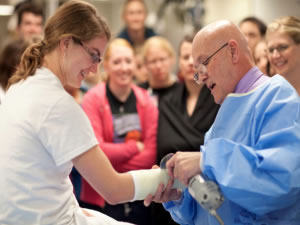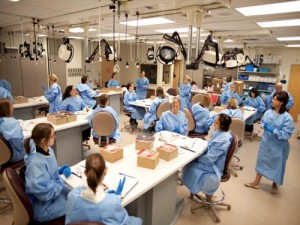Forbes Magazine has consistently named physician assistant studies the single best master’s degree because of the favorable outlook for salary and long-term employment of physician assistants (PAs). Talk to local hospitals or UW-La Crosse (UW-L) Career Services professionals, and you’ll see why.
“Frankly, these students, once they get their materials in place and learn how to identify positions, they don’t need me,” says Tim Tritch, interim director of UW-L’s Career Services. “They have employers seeking them out.”
Physician assistants have been increasingly in demand because they are trained to offer a broad range of diagnostic and preventative medical services — similar to what a doctor does. And it’s a time when doctors are in demand because of the increasing healthcare needs of an aging population and the anticipated increase in services due to the Affordable Care Act.
Gundersen Health System sees a fairly steady demand for the PA skill set, says Jon Nevala, manager of medical staff recruitment at Gundersen.
“Their clinical skill and expertise provides a valued extension to the service a physician can provide,” he says.
But it’s still too early to know the impact of the Affordable Care Act on PA recruitment, he adds.
The mission of UW-La Crosse’s Physician Assistant program is to provide much needed PAs to partner medical institutions in regions of Minnesota, Wisconsin and Iowa. It’s no doubt that this mission is being fulfilled. Since 2006 all 98 graduates — 100 percent — have gone on to be employed as physician assistants.
UW-L partners with local hospitals to provide a physician assistant program. UW-L handles the didactic portion and hospitals — Mayo Clinic Health System and Gundersen Health System — provide the clinical rotations.
UW-L’s PA program is truly a partnership between university and hospitals to meet that demand. In 1995 the group decided to collectively start a PA program with UW-L handling the didactic portion and hospitals — Mayo Clinic Health System and Gundersen Health System — providing the clinical rotations.
“The experience helps Gundersen fulfill its mission, but, likewise, provides the PA student an opportunity to experience different specialties,” says Nevala. “This experience helps in their clinical skill building and individual career planning.”
The clinics also provide feedback on curriculum and a selection committee comprised of both university and hospital representatives select the program’s future students.
In 2010 UW-L increased the size of its program from 14 to 19 students to meet the anticipated need for PAs at Mayo Clinic in Rochester.

UW-L partners with local hospitals to provide a physician assistant program. UW-L handles the didactic portion, and hospitals — Mayo Clinic Health System and Gundersen Health System — provide the clinical rotations.
“A lot of programs out there are not affiliated with a healthcare system,” says Sandy Sieck, program director for the UW-L PA program. “We are absolutely blessed to have the affiliation with both Mayo and Gundersen, which are both world-renowned institutions.”
The PA program is 23 months long with 12 months in the classroom and 11 months in clinical rotations. Clinical rotations are meant to be educational sites, not employment-seeking opportunities, but occasionally impressive students on clinical rotations are offered jobs.
UW-L has an academically strong applicant pool, which results in an impressive group of students entering in the program each year, notes Sieck. UW-L students have scored in the top 5 percent of PA programs nationally on the Physician Assistant National Certifying Exam, PANCE. The Journal of Physician Assistant Education ranked UW-L’s PA program No. 1 in the country based on current ARC-PA accreditation length, student-faculty ratio, percentage of faculty with doctoral degrees and most recent five-year average PANCE pass rates.
Sieck says the success of UW-L’s program is because of the students and excellent instruction from dedicated faculty. It also helps that the program is small.
“We have a pulse on what’s going on,” she says. “If a student is struggling … sometimes we know they are struggling before they know they are struggling.”
Meeting a rural need
UW-L students can apply for scholarships to work in under-served areas and get tuition reimbursement. All students have family practice clinical rotations in rural area as one of their outreach sites.
PA history
The PA profession was initially developed to meet a shortage of primary care physicians after the Vietnam War.

